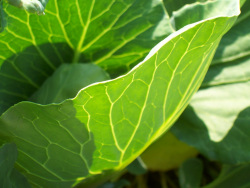
Planting for a Four Season Harvest, Part 7
Tender Crops
in Last
 The most tender crops, pole
beans and limas, go in last while pepper
plants and eggplant are set out.
The most tender crops, pole
beans and limas, go in last while pepper
plants and eggplant are set out.
At the very last I sow
winter squash --- not more tender, really than
the summer types which won't, however, be harvested until fall.
The small varieties are better for the backyard garden than Blue
Hubbard, while the dark-green, heart-shaped Quality now rates higher
with me than Butternut. It was even more vigorous growing in last
summer's drought than Butternut, and far more prolific. The
average fruit weighed 5 to 6 pounds, only one weighed 10, and it was
just as disease-resistant. Quality's chief virgue, however, is
the marvelous flavor of its fine-grained flesh. It can be eaten
immature, skin and all. Buttercup also has good flavor, but in my
experience is more susceptible to disease and insect attacks. I
also plant a few hills of Small Sugar pumpkin whose flesh is not
stringy, and which are good both for decoration and for pies.
The big rush is now
over. In a few weeks, though, short showing
must be made for these fall crops:
1---Brussels
sprouts;
2---Cabbage possibly, now
that the spring-planted varieties are
beginning to head up, or;
3---Chinese cabbage which
must be treated as a fall crop. If sown
in spring to mature in hot weather, it bolts and goes to seed, so
always sow Chinese cabbage in early summer to mature in fall;
4---Broccoli or
cauliflower, although it may be unnecessary to sow more
broccoli. Now ready to mature, the spring-sown plants in good
soil may continue to bear through summer and fall until frost and
after. Usually, though, I like to have a few plants come into
bearing in September;
5---Florence fennel which,
like Chinese cabbage, should mature in cold
weather;
6---Leeks for early next
spring while the spring-sown plants are used
in the fall and winter.
Sow the above in drills in
the ground, or in flats, then later
transplant. Fennel and Chinese cabbage are generally treated as
row crops --- sown and then thinned. I usually do transplant them
and have noted no setback in growth.
To be continued....
Tirrell, R. 1966, February. Planting for a 4-Season
Harvest. Organic Gardening and
Farming.
Reprinted by permission of Organic Gardening magazine. Copyright
Rodale, Inc., U.S.A. All rights reserved.
www.organicgardening.com.
Want more in-depth information? Browse through our books.
Or explore more posts by date or by subject.
About us: Anna Hess and Mark Hamilton spent over a decade living self-sufficiently in the mountains of Virginia before moving north to start over from scratch in the foothills of Ohio. They've experimented with permaculture, no-till gardening, trailersteading, home-based microbusinesses and much more, writing about their adventures in both blogs and books.
Want to be notified when new comments are posted on this page? Click on the RSS button after you add a comment to subscribe to the comment feed, or simply check the box beside "email replies to me" while writing your comment.
